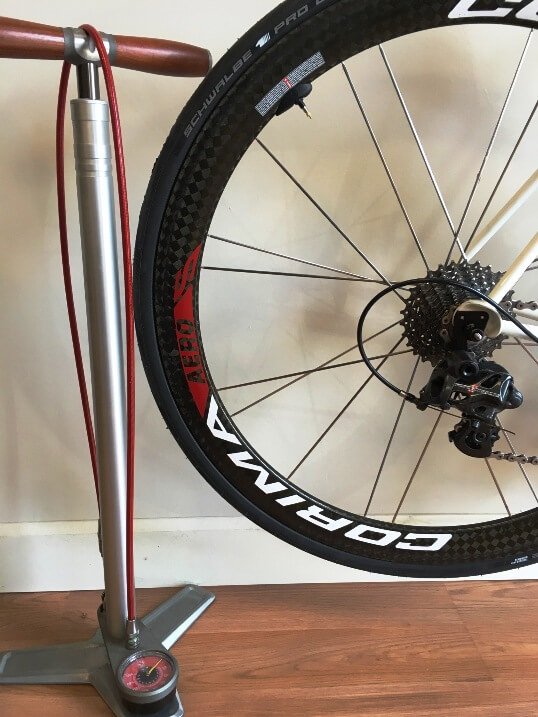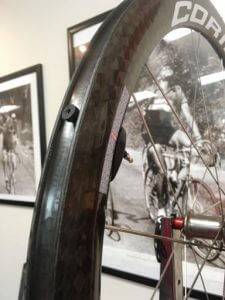Schwalbe Pro One Tubeless Tire – Low Rolling Resistance & Fast
 Schwalbe Pro One Tubeless Tire – Turning Theory into Reality
Schwalbe Pro One Tubeless Tire – Turning Theory into Reality
At Fit Werx, we’re always on the search for new products that improve the ride experience and performance of a bicycle. While doing some research for a client recently on new tire options, I came across some data on the Schwalbe Pro One tubeless tire that inspired me to do some testing of my own as the results looked promising in terms of capturing what tubeless tires have always held the potential to do, but what few have accomplished – reduce rolling resistance compared to a traditional tire and tube. How can a tubeless tire like the Schwalbe Pro One reduce rolling resistance? Theoretically, tubeless tires minimize hysteresis and internal friction between a tire and tube and thus they can minimize rolling resistance. However, theory and execution are often two different things and while tubeless road tires have often offered a great ride, they have not often had great rolling resistance numbers. The Schwalbe Pro One tubeless tire is one of the newer crop of tubeless tires that seem to be changing that equation without giving up the other great benefits tubeless tires can provide.
Baseline Continental GP4000 S II Baseline
Road conditions vary greatly in the New York metro area and northern NJ around Fit Werx in Ridgefield Park. They range from well maintained to loose and potholed. The winter months have been particularly mild in recent years and for the most part, I ride year round and my normal preference has been for tires with some puncture resistance, durability and control in wet conditions. In recent years, I have ridden and raced on 25mm Continental 4000S II’s with Vittoria latex inner tubes for the most part. With butyl tubes, the Continental GP 4000S II produces a coefficient of rolling resistance (Crr) of around 0.0036 which translates to about 12.2 watts at 18 mph at max PSI (120). A latex inner tube in general takes off a watt so that drops to around 11.2 watts at 120 PSI, but it is more like 12 watts at the 100 PSI I normally ride. The Conti’s ring up at around 220 grams, which is a fairly light set up for tire with good flat protection in the tread. For all of the combinations I have experimented with in recent years, this combination seems to be the right blend of speed and flat protection for me.
I usually use latex tubes in my clincher tires as they improve ride quality and lower rolling resistance compared to a butyl tube. But latex tubes can be a bit finicky and, even when properly installed, they lose air pressure quickly (almost a PSI per hour). The last thing I do before I leave for a ride is check my tire pressure, so losing a PSI an hour is never an issue for me. However, I know of a few clients who have trepidation about this fact. And with any clincher tire, punctures, pinch flats and snake bites are always a possibility. In other words, it would be great to find a tire with similar puncture and resistance and rolling resistance, but that can offer the lower tire pressure capability and flat resistance of a tubeless tire.
Tubeless Road Tires – The New Rolling Resistance King
Heading into 2017, tubeless ready road tires seem to finally be more of a focal point among the mainstream tire manufacturers and some new options out there are testing very fast indeed. I found new data that indicated that the fastest tire on the market at the moment appears to now be a tubeless tire – the Vittoria Corsa Speed TLR. In the same 18 mph test mentioned above, the Vittoria Corsa Speed TLR comes out at a mere 7.2 watts on a 25mm tire. That is fast indeed; in-line with Dean’s beloved (and out of production) Conti Supersonics!!
However, in terms of wear and puncture resistance, the Vittoria Corsa Speed TLR is not reinforced; while Vittoria has added graphene (an ultra light, ultra thin material which the company claims increases the strength and performance of the tire) for ’17 to the TLR, the tread on race tires is not designed to last long and thus it is not ideal for my regular riding and thus my search for low rolling resistance in a more durable tire continued.
Schwalbe Pro One Tubeless Tire – The Right Balance?
 After a bit more research, I came upon the new Schwalbe Pro One tubeless ready tire, a complete revamp of the Schwalbe One Tubeless tire that was released last season. The prior version was made with a butyl layer that created an air tight seal. While this worked well, the tire was a bit heavy. The new Schwalbe Pro One cuts the weight by about 25% and substantially improves the rolling resistance along the way. Promising for sure. In the same test format mentioned above, the Schwalbe Pro One tubeless tire with 20 milliliters of sealant comes in at 11 watts at 120 PSI and 11.6 watts at 100 or about half a watt faster than my normal Conti set up with latex tubes. The Schwalbe Pro One tubeless tire does have a reinforced tread and sidewall so it rates about the same as the Conti, but with sealant installed, small punctures should prove unlikely while pinch flatting should theoretically be impossible.
After a bit more research, I came upon the new Schwalbe Pro One tubeless ready tire, a complete revamp of the Schwalbe One Tubeless tire that was released last season. The prior version was made with a butyl layer that created an air tight seal. While this worked well, the tire was a bit heavy. The new Schwalbe Pro One cuts the weight by about 25% and substantially improves the rolling resistance along the way. Promising for sure. In the same test format mentioned above, the Schwalbe Pro One tubeless tire with 20 milliliters of sealant comes in at 11 watts at 120 PSI and 11.6 watts at 100 or about half a watt faster than my normal Conti set up with latex tubes. The Schwalbe Pro One tubeless tire does have a reinforced tread and sidewall so it rates about the same as the Conti, but with sealant installed, small punctures should prove unlikely while pinch flatting should theoretically be impossible.
Schwalbe Pro One Tubeless Tire on Non-Tubeless Ready Rim
 So, trusting the independent tester information on rolling resistance for the Schwalbe Pro One tubeless tire, I decided to take the plunge, but not without adding a few more test elements into the equation. I wanted to see how well a tubeless conversion would go on a standard (non-tubeless ready) carbon rim, how well the tire would hold air, and what the weight impact would be. For the test wheels, I selected a set of Corima 47 clincher rims. The Corima rims have a slightly offset spoke pattern, so I figured these might be tricky to get to work well, but I wanted to pick a potentially challenging wheel to test and I really like the way these wheels ride and wanted to see if I could get them to work well with a tubeless tire. To complete the conversion, I used Silca Platinum rim tape, Silca tubeless valves and 25 milliliters of Stan’s Notubes tire sealant per rim.
So, trusting the independent tester information on rolling resistance for the Schwalbe Pro One tubeless tire, I decided to take the plunge, but not without adding a few more test elements into the equation. I wanted to see how well a tubeless conversion would go on a standard (non-tubeless ready) carbon rim, how well the tire would hold air, and what the weight impact would be. For the test wheels, I selected a set of Corima 47 clincher rims. The Corima rims have a slightly offset spoke pattern, so I figured these might be tricky to get to work well, but I wanted to pick a potentially challenging wheel to test and I really like the way these wheels ride and wanted to see if I could get them to work well with a tubeless tire. To complete the conversion, I used Silca Platinum rim tape, Silca tubeless valves and 25 milliliters of Stan’s Notubes tire sealant per rim.
To prep the rim, I first removed the old tires, tubes and rim tape (and trued both wheels since I had it all apart anyway!) Once I had the rim tape off, I cleaned the inside of the rim and in particular the hook area with just some soapy water and a sponge. I then applied two wraps of Silca rim tape, slowly pressing the tape into the rim and under the hook to provide as much clearance as possible for the tire bead to engage the rim. After that, I installed the Silca valves which include a rubberized aero cover for the valve stem. Silca states that the valve stem need only be hand tightened, but we pulled out a plier to gently tighten this up a bit further just to make sure.
Once the valve stem was installed, I applied some soapy water to the tire bead and the rim itself and installed the tire. I used a CO2 cartridge to rapidly  pressurize the tire and then a floor pump to get the pressure up to around 110 PSI. On the front wheel, the tire actually held that 110 PSI for almost the entire day with no sealant whatsoever. The rear sealed well but did lose around 15 PSI after a few hours so we deflated both the front and rear tires, removed the valve cores and used a plastic syringe to add sealant to both rims. Next came the waiting game with some periodic spinning of both rims to spread the sealant. The result? After about 24 hours (day three in the process) both tires lost around 5 to 10 PSI. So that was definitely a successful installation. As the sealant works its way around the tire bead, I suspect this will seal even more securely over the next week or so.
pressurize the tire and then a floor pump to get the pressure up to around 110 PSI. On the front wheel, the tire actually held that 110 PSI for almost the entire day with no sealant whatsoever. The rear sealed well but did lose around 15 PSI after a few hours so we deflated both the front and rear tires, removed the valve cores and used a plastic syringe to add sealant to both rims. Next came the waiting game with some periodic spinning of both rims to spread the sealant. The result? After about 24 hours (day three in the process) both tires lost around 5 to 10 PSI. So that was definitely a successful installation. As the sealant works its way around the tire bead, I suspect this will seal even more securely over the next week or so.
Schwalbe Pro One Tubeless Weight vs. Continental GP4000 SII
We weighed both rims before and after and the switch to the Schwalbe Pro One from the Conti saved about 10 grams so a negligible weight impact, in fact a very small weight savings.
Riding the Schwalbe Pro One Tubeless Tire
On a short test ride at around 110 PSI the Schwalbe Pro One tubeless tires felt pretty quick and grippy, very comparable to the Continental GP 4000 S II that I was used to. But the real difference was when the PSI in the Schwalbe Pro One tubeless tire was closer to 85 to 90 PSI, levels where the risk of a pinch flat on the Conti’s with tubes creeps up. At 85 to 90 PSI, the Schwalbe Pro One tubeless tires felt absolutely plush with a noticeable increase in traction.
Schwalbe Pro One Tubeless Tire Conclusions
With the Schwalbe Pro One tire, I end up with a tire that is marginally faster than my normal clinchers with latex tubes with the added benefit of being able to run an entire range of PSI levels and eliminating almost all of the risk of pinch flats or heat related flats from the brake track. My initial impressions of the Schwalbe Pro One tubeless tire mounted on the Corima 47 are very good, now I just need to test it more over the long-term! I plan on running this tire set up through the rest of the fall and winter for 2016 and heading into 2017; I’ll come back and update this post after some more miles have been logged… I also plan to recreate this test with the Vittoria Corsa Speed TLR as race season approaches next year as 7.2 watts is really fast! Between the Schwalbe Pro One for training and the Vittoria Corsa Speed TLR for racing, tubeless road tires may have truly come into their own and become the very best performing tires on the market.
Contact us for more information on the Schwalbe Pro One tubeless tires or to discuss options.








Thanks for the excellent article
I have been using a (different tire) for a few years now and was leary about changing.
After one ride I would say the Schwalbe feel very similar and just as fast